
NVIDIA G-SYNC ULMB 2 makes your 360Hz G-SYNC monitor look as smooth as a 1440Hz one
After coming up with DLSS 3 to generate frames with the power of AI, G-SYNC ULMB 2 is now here to make your monitor feel faster. This is done with backlight strobing, and while many enthusiasts will scoff at it, G-SYNC ULMB 2 does things a bit differently from the first-gen ULMB.
With ULMB 2, you get to still enjoy the full brightness and maximum refresh rate of your monitor by having full refresh rate backlight strobing. The backlight is only turned on as and when the colors of each pixel has changed, eliminating the blur that happens when pixels are transitioning.
This is actually more challenging than it sounds when a monitor is running at 360Hz, as the optimal window for the backlight strobing is extremely miniscule. And that’s why NVIDIA harnesses G-SYNC to determine the right time to turn on the backlight, eliminating blurring with what they call Vertical Dependent Overdrive.
Overall, the goal is to improve the sharpness on high refresh rate G-SYNC displays, by eliminating all semblance of motion blur. The effective motion clarity as calculated by NVIDIA for a 360Hz monitor is actually 1440Hz, and they even came up with a demo showing a 120Hz panel with ULMB 2 with objects in motion looking way sharper than a 480Hz one, sans ULMB 2.
There are several requirements that NVIDIA has set for a monitor to feature ULMB 2:
- Deliver over 1000 Hz of effective motion clarity
- Drive ULMB 2 at the monitor’s full refresh rate
- Deliver over 250 nits of brightness with minimal crosstalk or double images

There are already two monitors in the market that support ULMB 2 via a simple firmware update, the Acer Predator XB273U F and the ROG Swift 360Hz PG27AQN. In the near future, there’s going to be the 540Hz ROG Swift PG248QP and AGON AG276QSG.
I do believe that this technology is a clear differentiator between monitors that feature G-SYNC, with a discrete G-SYNC module, and those that support VESA AdaptiveSync or FreeSync. In the future, I wonder if NVIDIA will refine this capability further where we will see mini-LED panels able to flash individual backlighting zones, to also enhance the visual experience in darker games, where you don’t want your display to be all gray.










